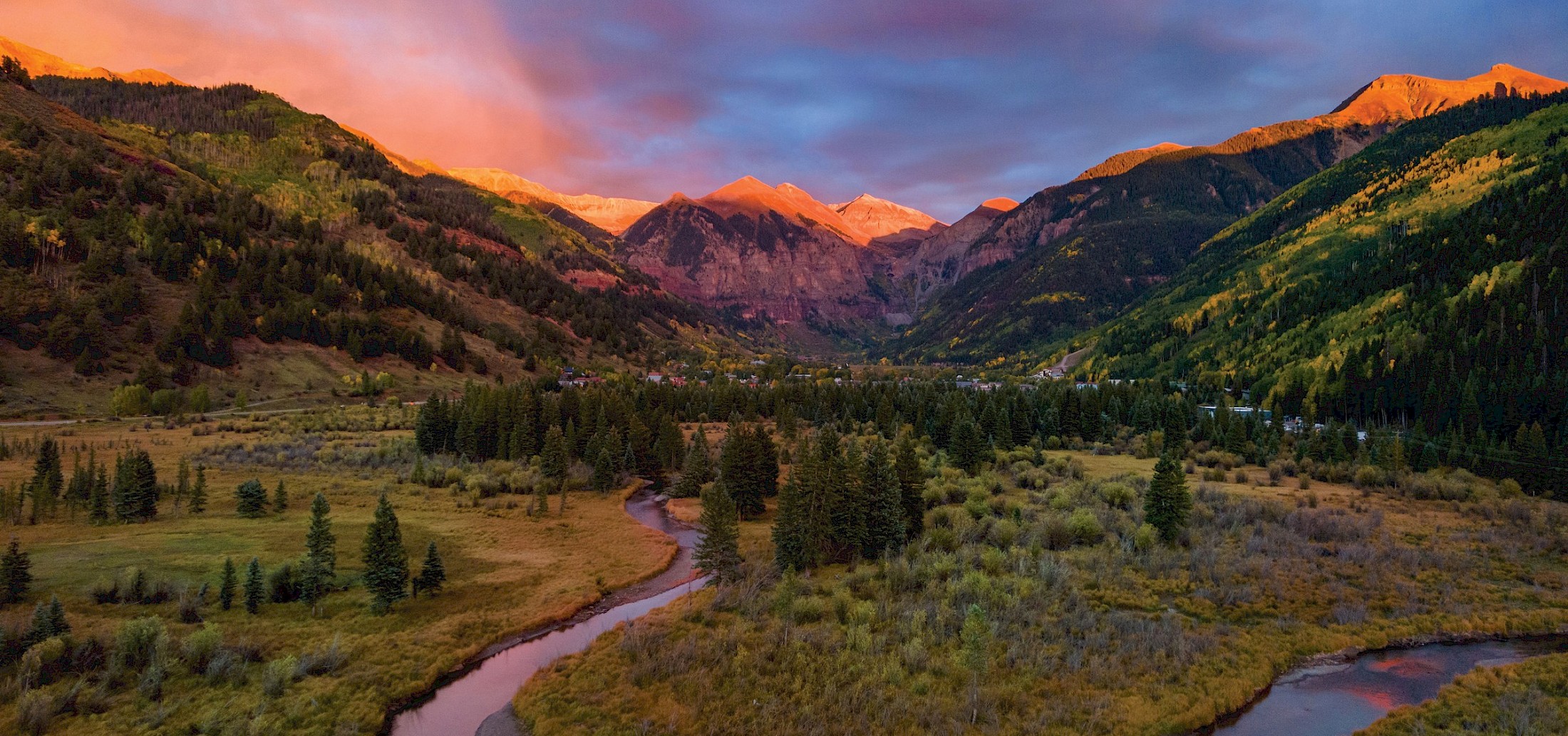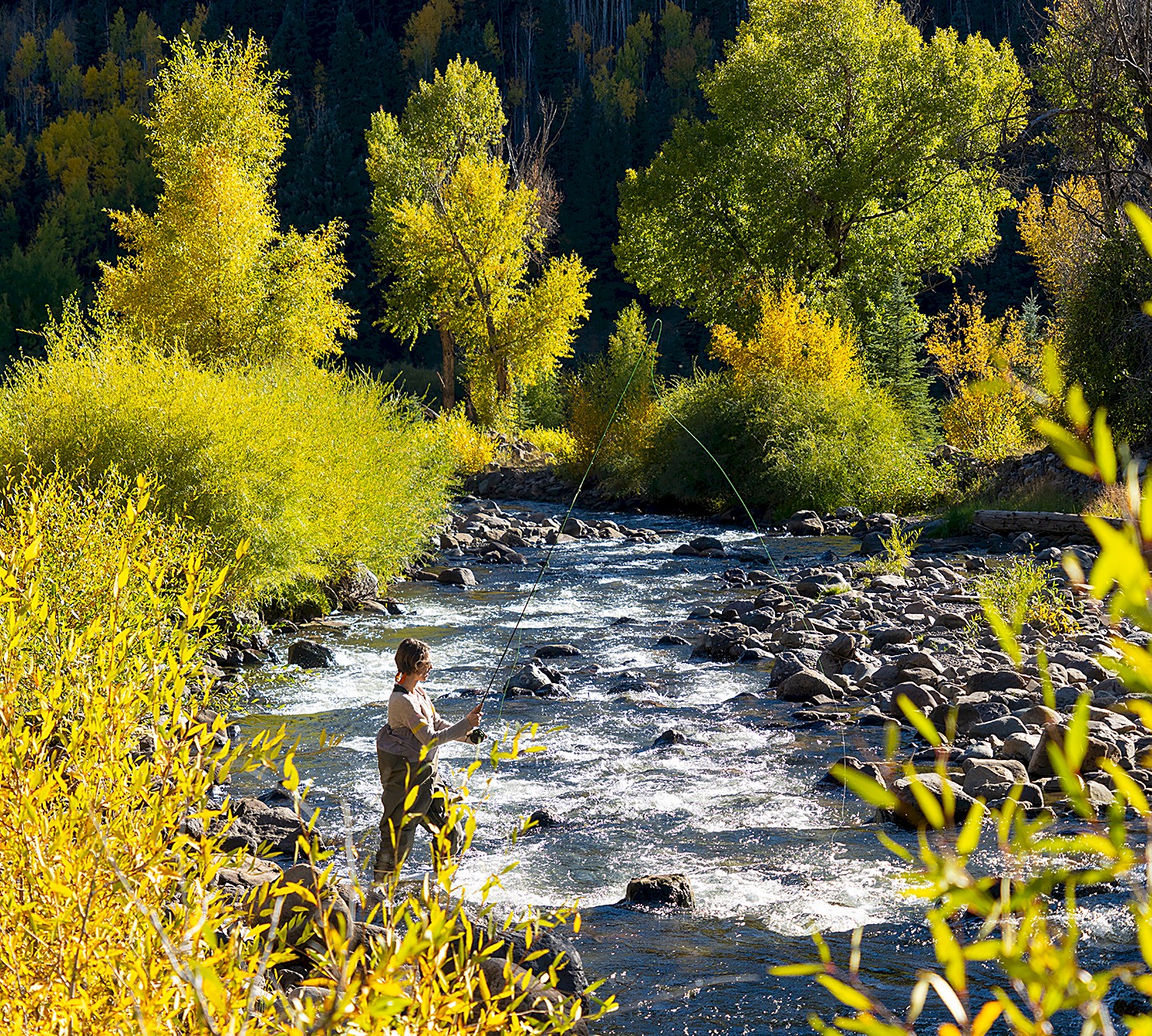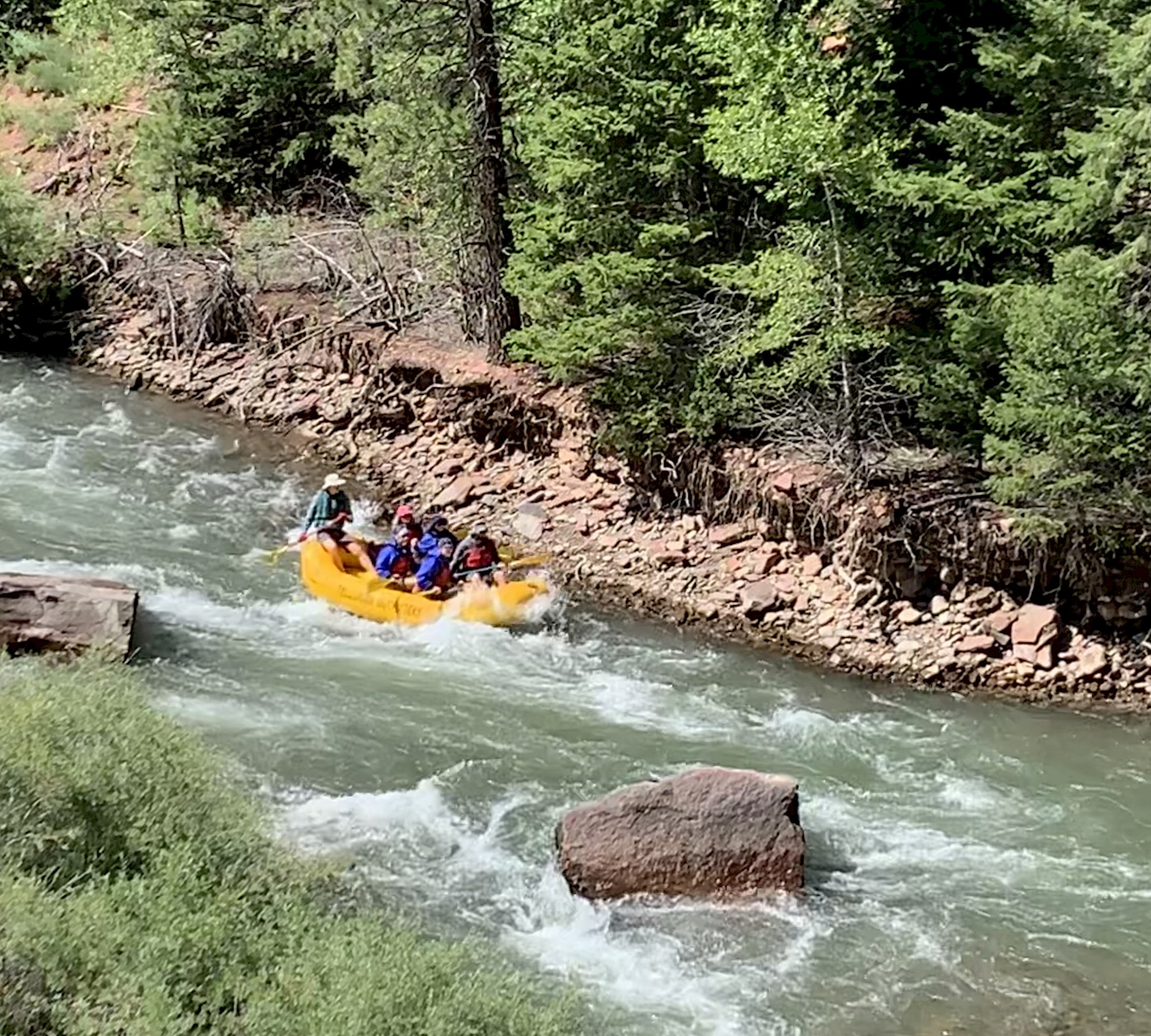Magnificent San Miguel
One of the only free-flowing rivers in Colorado, the San Miguel River has a story to tell.
By Erin Spillane
Brooke Duncan has lived all her life beside the San Miguel River. The 17-year-old recalls falling asleep on summer nights with the windows wide open at the Duncan family home in Ilium Valley, the river their lullaby. One of her earliest memories is fishing with her father, John Duncan, Telluride Outside co-owner, longtime guide and angler. At the time, the pair were fishing on the river from their backyard, where Brooke remembers feeling that tell-tale tug on her line. “I said, ‘Dad, Dad, I have a fish,’ ” she recounts. “He was busy tying a fly on and said something dismissive like ‘Yeah, yeah, whatever.’ ” The fish turned out to be a rainbow trout, and Brooke recalls her pride in catching the notoriously finicky, and therefore highly prized, fish at the tender age of just 2 years old.
The San Miguel River is like that, playing host to innumerable small and happy moments like Brooke’s with her dad. It is also an incredibly unique waterway with a fascinating history. Clearly a special place, those who love Telluride know the magnificent San Miguel as a place for summertime recreation, but also as beautiful and important, wild and free.
River 101
The San Miguel River’s headwaters begin as rivulets and runoffs of precipitation and melting snows that trickle along rocky talus slopes, alpine meadows and drainages high in the mountains east and south of Telluride. Eventually, they combine into streams — some minor, while others are spectacular, like Ingram, Bridal Veil and Bear creeks, which tumble over falls at the east end of the box canyon.
One way or another, they ultimately feed into the waterway known as the San Miguel River, which gathers at the east end of the Telluride valley. From there, the river skirts the southern end of town and drifts out across the Valley Floor, the roughly 570-acre parcel west of Telluride that has been preserved as open space. It then charges downhill through Keystone Gorge toward its confluence in Ilium Valley with a major tributary, the South Fork of the San Miguel, whose own origins lie southward in the lakes and streams above the nearby communities of Ophir and San Bernardo.
The river continues onward, dropping into terrain that becomes increasingly more arid and less alpine as it follows a course north and west across high deserts and ranchlands. A broader, more mellow San Miguel eventually empties into the Dolores River in red rock just short of Colorado’s border with Utah. Not too long after that is the Dolores’ confluence with the Colorado River, where the waters of the San Miguel join with this waterway so emblematic of the American West.
Human activity
As early as the 1300s, bands of Nuchu, or Utes as European settlers called them, spent summers camping in the Telluride valley, fishing in the San Miguel River, hunting and gathering plants. The first Europeans arrived in numbers in the 1860s and within a decade the first mining claims had been staked. In the early 1880s, the arrival of still more prospectors and other settlers had forced the Nuchu out of the valley altogether and onto reservations in southern Colorado and eastern Utah.
Colorado’s mining boom was underway and with it the San Miguel River took on new roles, as the site of hydraulic mining and a place to dump tailings, the gravelly waste product left over from mineral extraction. Theresa Koenigsknecht, director of education and outreach at the Telluride Historical Museum, says of this period, “We can see that the river is beginning to be changed by human activity.”
Koenigsknecht continues, “The river was also the first waste management facility. People would dump everything in it. We know, for example, that around 1900 there were problems with dead hogs, household refuse and human waste going into the river.”
Human activity also affected the river’s actual shape. Johnnie Stevens, who grew up in Telluride and worked in the mines in the 1960s as a college student on summer break, points to the arrival of the Rio Grande Southern Railroad, which operated a service to Telluride from 1890 until 1952. “There is no question that when the railroad came to town, it did some river rerouting on portions of the Valley Floor,” Stevens says. “It also had to construct many small bridges to get over some wetlands and water generally.”
According to Stevens, more extensive and obvious straightening of the river came later. Stevens recalls that after the Idarado Mining Company purchased Telluride Mines in 1953, it bought the Valley Floor to store tailings. Says Stevens, “In order to de-water the area west of the town and for future tailings expansion, the river was rerouted west of Boomerang Road.”
For more than 50 years, the river followed this man-made course, running arrow-straight along the southern side of the Valley Floor. Change, though, was coming.
A river restored
By the autumn of 2009, the Town of Telluride had acquired the Valley Floor and approved a conservation easement that preserved it as open space. Next, the Town and others turned to restoring portions of the river on the Valley Floor to their former natural state in order to improve the health of the river and the surrounding environment.
Since 2016 and with the assistance of Valley Floor Preservation Partners, the State of Colorado, Gunnison Gorge Anglers (the local Trout Unlimited chapter) and San Miguel Watershed Coalition, the Town of Telluride has restored approximately two-thirds of the river as it passes through the Valley Floor. Town of Telluride Program Director Lance McDonald describes these efforts as “relocating the river out of its channelized condition into new, meandering alignments where the river is free to adjust its course along the natural floodplain. The restored channel is now a much-improved aquatic habitat with pools, riffles and eddies forming and reforming within the river system.”
McDonald adds that the work is part of a series of restoration projects, with Telluride Town Council currently eyeing another phase that will focus on Eider and Mill creeks, both of which feed into the San Miguel River on the Valley Floor.
Wild San Miguel
What about the ecology of the 80-mile-long river as a whole, and of its watershed?
Adrian Bergere is the executive director of the San Miguel Watershed Coalition, a regional nonprofit that advocates for the river and its watershed. Bergere describes the San Miguel River as one of the last few ecologically and hydrologically intact river systems in Colorado. He adds that the river’s million-acre watershed, which is the vast area drained by the river and its tributaries, lies within one of the largest relatively undisturbed areas left in North America. Says Bergere, “It’s an incredibly special place.”
“We are in the San Juan Mountains, which are the most recently formed range in Colorado, which is why they are so steep and jagged,” Bergere explains. “So, we transition very quickly from a high-alpine environment to an equally beautiful desert landscape. From that perspective, the watershed is unique to begin with and then there’s the fact that we don’t have a dam on the San Miguel River. Unlike most other rivers across the West, the San Miguel is free flowing, or what is referred to as a freestone river.”
Despite its relatively unspoiled quality, Bergere points to adits [horizontal passages leading into a mine] and other leftovers of the mining era, which exist along the river, and notes, “There are definitely scars ... the San Miguel has seen it all.”
Still, he adds, the watershed is home to a range of riparian environments and wildlife. Animals found in the area include lynx, bobcat, black bear, beavers, elk, mule deer, pica and a multitude of birds, like the fascinating Gunnison sage grouse. In the chilly upper river, there are rainbow, cutthroat and brown trout. Further downstream, where the water is warmer, are bluehead sucker, roundtail chub and flannelmouth sucker. Says Bergere, “There is a lot of life in the San Miguel watershed.”
He continues, “In my work, I have spent thousands of hours standing in the river and I can say that there is nothing like it and no better way to connect with nature. Anytime I can be around the river, I am happy.”
Splashy fun
In the 1970s, when outdoor recreation replaced mining as the economic driver along the upper reaches of the San Miguel River, the ways humans interacted with it shifted too. There was an increased interest in the health of the river and watershed, as well as an uptick in on-river recreation, primarily rafting and fishing, and later paddleboarding.
Telluride Outside’s John Duncan remarks that the qualities that make the river unique also make it perfect for recreation, including fishing. “We perhaps don’t recognize that the moving-water experiences that we have are often taking place on waterways that are dam regulated,” he says. “The water itself, the amount of water, the pace of water, the temperature of water are all regulated. This is the case unless you are on one of the few remaining freestone rivers, and the San Miguel is one of them. I think that is incredibly special.”
It also makes for memorable experiences for his fishing clients, Duncan notes. “When we are guiding on the San Miguel, we start by making observations of what’s going on that day with the river. We take the water temperature and observe water levels and clarity. We stick our hand in the water to see how it feels. We turn over rocks to see what insects are prevalent, what stage of development they are in, what hatches we are going to observe. It’s super real and it captures people’s curiosity, whether they have been fishing forever or are just starting.”
Michael Doherty, or MD as he is known, is the founder/owner of Telluride Outfitters, an adventure guide company based in Mountain Village. Get MD talking about rafting on the San Miguel and he manages to sound both reverent and wildly enthusiastic. “My favorite quote is that the Amazon goes 4,000 miles and drops 50 feet and the San Miguel goes 80 miles and drops 7,000 feet,” he says. “That gives you an inkling of how dynamic this wild and scenic river actually is.”
MD enthuses on the availability of rapids just minutes from the Telluride Outfitters base. “It is so amazing that we can go from Mountain Village, drive 10 minutes and put boats in the water at Deep Creek. We can raft all the way down to Placerville, or beyond to the take-out just before the Norwood bridge, and experience one of the most dynamic, enchanting and special areas of the San Miguel.”
MD continues, “We navigate a drop of approximately 65-70 feet of elevation per mile so in our 10-mile stretch we drop up to 700 feet. It makes for fun, splashy Class III rapids.”
That enthusiasm shows itself over the next several minutes as the experienced guide describes every section of the river right up to where it ends at the Dolores. As the conversation winds down, MD shares a story that feels a lot like Brooke Duncan’s, a reminder that the San Miguel, while ecologically and historically important, is also a memory maker for so many.
“One of my favorite things about the river is the ability to observe wildlife closely — it’s so abundant. We were on the river once and I saw what looked like a three-pointed stick coming out of the water. The next day I came back with a friend to retrieve it. It was a seven-point elk shed from what must have been a massive bull elk. Pulling it out of the water was like pulling the Excalibur sword from the stone. We rode the river with this huge antler shed strapped to the bow of the boat.”
Adds MD, “It was just another reminder that the San Miguel River is just the coolest place — ever.”




